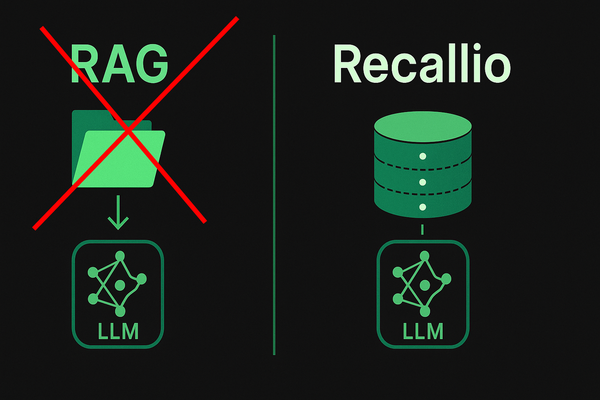RAG 2.0: How to Build Retrieval‑Augmented Generation Pipelines That Don’t Break in Production

Retrieval-Augmented Generation (RAG) used to be an experimental hack.
Today, it’s a core production strategy for everything from AI copilots to legal research tools. But if you’ve deployed RAG in the wild, you know the pain: hallucinations, high token costs, inconsistent answers, and brittle pipelines that break under real traffic.
If you’ve ever launched a Retrieval-Augmented Generation (RAG) app and watched it fall apart in production, you’re not alone. Maybe it started strong during testing. Clean answers. Great context. Happy demos. But in the wild? The cracks show fast. The model forgets context, fetches irrelevant data, hallucinates facts, or returns empty answers when retrieval fails.
This isn’t a tooling issue. It’s a system design issue. And it’s exactly why RAG 2.0 is gaining traction. RAG 2.0 isn’t just a tweak. It’s a rethinking of how LLMs and memory interact under production stress. If RAG 1.0 was about connecting search to a prompt, RAG 2.0 is about making that connection resilient, efficient, and measurable.
Why RAG 1.0 Isn’t Enough
Let’s talk symptoms. Here’s what breaks in classic RAG systems:
- You get a giant blob of context that overwhelms the model.
- Or worse, you get too little and the LLM fabricates answers.
- Results vary wildly depending on how the question is phrased.
- There's no fallback logic when retrieval comes up empty.
- And the model returns unstructured free text that’s impossible to automate.
What’s missing is structure. Predictability. Guardrails. RAG 2.0 brings those into play.
From Hack to Infrastructure: What RAG 2.0 Actually Means
RAG 2.0 treats memory like a first-class system component. Not a plugin. Not a bolt-on. It borrows lessons from distributed systems, search engines, and API design. It’s not just about better results—it’s about building a memory system you can reason about.
Here’s what that looks like in practice:
- Combine keyword and vector search so you don’t miss exact matches.
- Clean and filter chunks before they hit the model.
- Enforce structured outputs so you can parse responses.
- Build observability into every step—from recall to generation.
Let’s break down the architecture that makes all this work.
The RAG 2.0 Blueprint
Imagine a user asks a question. Here’s how your pipeline should behave:
- The question goes to a hybrid retriever. One leg runs semantic search (vectors), the other runs keyword (BM25).
- Top results are merged, deduplicated, and filtered.
- Chunks are scored for relevance, diversity, and source quality.
- The final context is passed into an LLM via structured function-calling or enforced schema.
- The model responds with clean JSON—not prose.
- A post-processing layer verifies structure and routes the output.
At every step, you log and track what happened. That’s not optional. It’s essential for debugging, tuning, and proving your system is working.
Hybrid Search: The Non-Negotiable
Semantic search is seductive. It’s fuzzy, flexible, and great for generalization. But it’s also fragile. It misses specifics. Keyword search, on the other hand, finds the exact phrase “2023 earnings call” buried in a PDF. RAG 2.0 says: use both.
Blend scores. Compare results. Use vectors for breadth, BM25 for anchor points. This isn’t overkill. It’s basic due diligence.
Chunking Is Not a Trivial Detail
How you chunk your data controls everything downstream. Context fit, recall precision, token usage—it all depends on chunking.
Tips:
- Stick to 300–500 tokens per chunk.
- Add 50-token overlaps to preserve continuity.
- Tag every chunk with metadata: source, author, timestamp, scope.
- Avoid splitting in the middle of logical units like paragraphs or bullets.
Good chunking creates memory. Bad chunking creates noise.
Structured Output: Stop Letting LLMs Ramble
If your model outputs paragraphs, you’re losing control. You can’t chain outputs. You can’t parse results. You can’t guarantee quality.
The fix: define a schema. Enforce it. Use function-calling (OpenAI), tool-use (Anthropic), or output validators (Guardrails, Outlines). Your model should respond like an API, not a creative writer.
Example schema:
{
"answer": "Revenue was up 20%",
"sources": ["https://example.com/report.pdf"],
"confidence": 0.93
}Real World Case: Financial Research Copilot
We built a copilot for equity analysts. First version used vanilla vector search and prompt templates. It worked until it didn’t. Retrieval pulled outdated reports. Models hallucinated missing numbers. Responses had no audit trail.
RAG 2.0 fixed it. We:
- Used hybrid search to improve context.
- Added TTL to memory to avoid stale data.
- Required model to output structured JSON.
- Logged every retrieval hit and fallback.
Now, the analyst gets:
- A concise summary.
- The exact page in the 10-K.
- A confidence score.
- A fallback when data is missing.
That’s what production looks like.
Observability: The Unsung Hero
You wouldn’t run a database without monitoring. Don’t run RAG without it. Track:
- Retrieval hit rates.
- Vector vs. keyword ratios.
- Token counts per request.
- Schema conformance failures.
- Latency and error codes.
Alert when:
- Too few chunks are retrieved.
- Output schema fails validation.
- Confidence scores drop below threshold.
Bonus: Advanced Tactics for Production Teams
- Use different LLMs for different jobs. One to rerank, another to generate.
- Inject user profile data into prompts for better personalization.
- Pin key chunks that must always be included.
- Add memory scoring layers (freshness, frequency, source trust).
- Rerank chunks post-retrieval using another LLM pass.
These are not theoretical. These are the tactics teams use to survive real traffic.
Closing Thoughts
RAG 2.0 isn’t a buzzword. It’s a shift in how we build AI systems that scale. It moves from prompt hacking to system design. From clever demos to reliable infrastructure.
The next wave of AI products won’t just generate—they’ll remember. They’ll reason. And they’ll return results you can trust.
But only if you build them right.
That’s what RAG 2.0 is for.
Ready to give your AI Agents smart memory?




